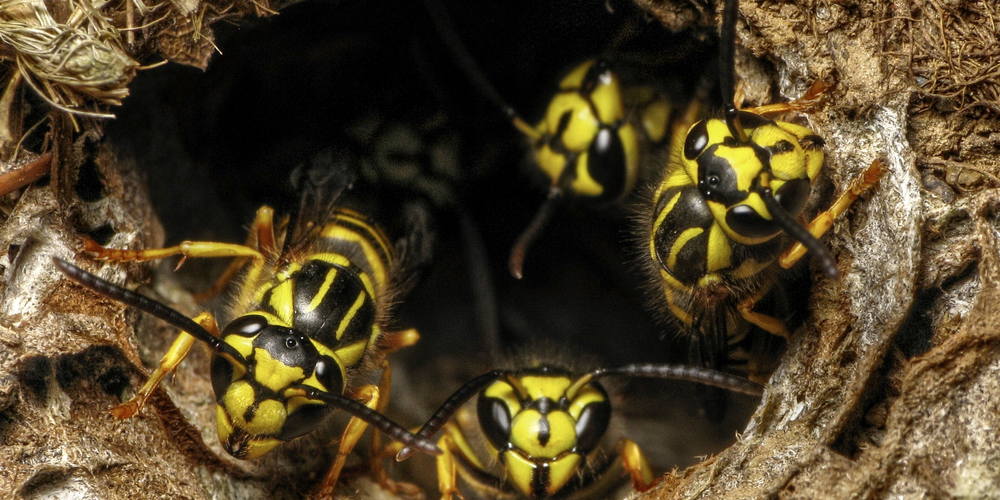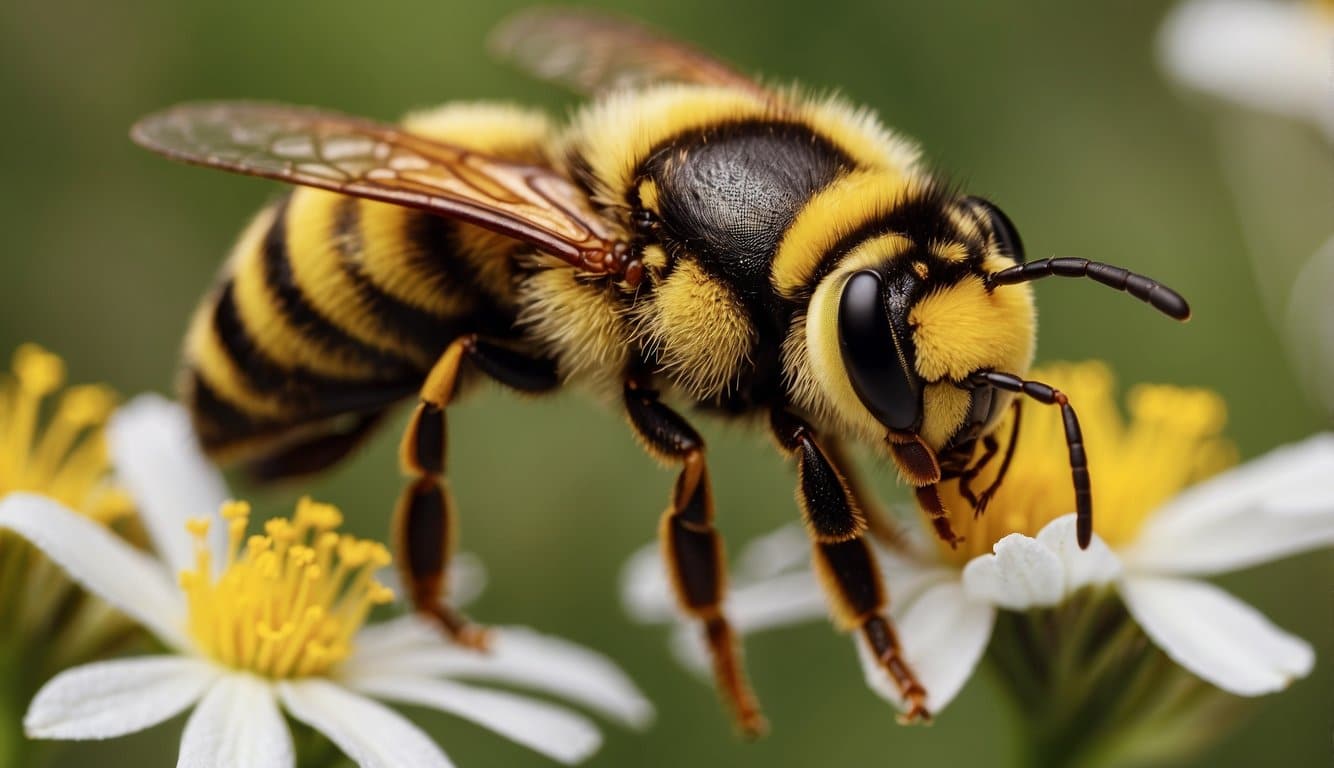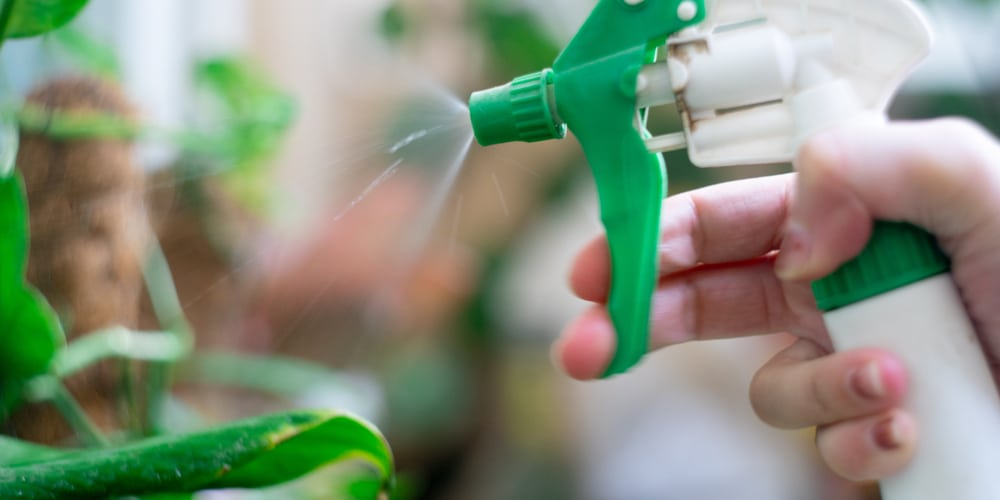Eliminating Yellow Jackets: Step By Step
Step 1: Locate the Nest
- Question: Have you located the yellow jacket nest?
- Yes: Proceed to Step 2.
- No: Observe where the yellow jackets fly at the lowest point to trace back to their nest. Do this with caution.
Step 2: Assess the Situation
- Question: Is the nest in a high-traffic area?
- Yes: Immediate removal is advised for safety.
- No: If the nest poses no direct threat, consider leaving it until late fall when yellow jackets naturally die off, except for the queen.
Step 3: Plan for Removal
- Preparation: Choose a time and method.
- Time: Plan to treat the nest late in the evening or early morning when yellow jackets are less active.
- Safety Gear: Wear protective clothing—long sleeves, pants, gloves, and a veil or hat with a net to protect your face and neck.
Step 4: Choose a Treatment Method
- Options:
- Insecticidal Dust: Effective for ground nests. Apply directly into the nest entrance, then cover with soil.
- Aerosol Insecticide: Suitable for aerial nests. Spray directly into the nest opening.
- Natural Alternatives: For less immediate risk, consider using dish soap and water mixture sprayed directly into the nest or entrance to suffocate the yellow jackets.
Step 5: Apply the Treatment
- Action: Safely apply the chosen treatment.
- Procedure: Approach the nest slowly and quietly to avoid disturbing the yellow jackets. Apply the insecticide according to the manufacturer’s instructions or your prepared mixture vigorously.
Step 6: Monitor and Secure the Area
- Action: After treatment, monitor the nest from a safe distance.
- Follow-up: Check the next day for any activity. It may require multiple treatments.
Step 7: Remove the Nest
- Question: Is there no more activity observed?
- Yes: If safe, remove the nest to prevent future colonization. This is best done in the late fall or winter.
- No: Additional treatments may be necessary.
Step 8: Prevent Future Nests
- Preventive Actions:
- Seal Entrances: Caulk cracks and crevices around the home.
- Remove Food Sources: Keep food covered during outdoor events and ensure garbage bins are tightly sealed.
- Limit Attractive Landscaping: Yellow jackets are attracted to certain plants and water sources. Manage landscaping to be less appealing.
Step 9: Professional Removal
- Question: Is the infestation large or too risky to handle on your own?
- Yes: Consider hiring a professional pest control service. This is safer, especially for large or inaccessible nests.
Additional Tips
- Avoid swatting at yellow jackets as this can make them more aggressive.
- Use caution with insecticides around pets and children, and follow all safety guidelines.
Identifying Yellow Jacket Nests
When yellow jackets are zooming around your space, it’s like a mystery waiting to be solved: where’s the nest? Here’s your detective kit for spotting those pesky headquarters:
- Location Clues: Stillness is your friend. Stand back and observe; yellow jackets often betray their base with a flight path straight to the entrance.
- Nest Types:
- Aerial Nests: These are the high-fliers. Hang tight and look up! They’re often under eaves, or in trees and can be paper-like and gray.
- Ground Nests: Sneaky! They can be in old rodent burrows or even in the cracks of your sidewalk. Watch for the traffic of yellow jackets entering and exiting.
Here are a few steps to guide you in uncovering their hideouts:
- Peak Hours: Scope out the area during late morning or early afternoon when yellow jackets are most active.
- Safety First: Tut, tut! No touching. Keep a safe distance to avoid stings.
- Markers: Spot something? Temporarily mark the area. It helps if you need to call in the calvary (aka pest control).
Wondering how to tackle aerial or ground nests? Here are some strategies:
- For an all-terrain approach to nests in your backyard, you can find detailed extermination tips here.
- Aiming for the high-up, twiggy condominiums? This resource guides you through safe handling of aerial nests.
Safe Approaches for Yellow Jacket Removal
Before you charge into battle against yellow jackets, arm yourself with these safe removal strategies. They’ll ensure you’re effectively dealing with the pests while keeping your hide intact.
DIY Trap Construction
To create your own DIY yellow jacket trap, follow these steps:
- Gather materials: You’ll need a 2-liter plastic bottle, scissors, bait, and a string for hanging.
- Craft the trap:
- Cut the top third of the bottle off and invert it, so it looks like a funnel.
- Place this funnel piece back into the bottle’s body, creating a one-way entrance for yellow jackets.
- Secure the trap: Tape around the bottle’s edge to ensure the two pieces stay together.
Attach a string to the top of your trap to hang it near yellow jacket activity, but away from areas you frequent.
Bait Selection for Traps
Choosing the right bait is crucial for your trap’s success:
- Meat or fish: In the spring or early summer, yellow jackets prefer proteins. Use small pieces of meat or fish to attract them.
- Sweet liquids: Later in the year, opt for sugary substances. Try diluted fruit juice or soda.
Always remember to regularly check and clean out the trap, replacing the bait as needed to continue catching these pesky insects.
Professional Yellow Jacket Extermination
When yellow jackets turn your outdoor haven into a no-go zone, you might need to call in the pros. Here’s what professional extermination looks like:
- Assessment: Your chosen expert will inspect your property to find the nests. These could be tucked
Preventive Measures to Keep Yellow Jackets Away
Before you invite guests over for your next backyard barbecue, take steps to ensure uninvited stinging insects don’t crash the party. Below, you’ll find targeted strategies to maintain a yellow jacket-free zone.
Natural Repellents
- Essential Oils: Yellow jackets dislike certain scents. Lemongrass, peppermint, and clove essential oils can act as deterrents. Mix a few drops with water and dish soap to create a homemade spray for areas where yellow jackets frequent.
- Cucumber Peels: Place cucumber peels around your patio or deck. These peels contain a compound that yellow jackets find particularly distasteful.
Landscaping to Deter Yellow Jackets
- Trash Control: Keep outdoor trash bins tightly sealed. Regularly clean them to eliminate any lingering food scents that could attract yellow jackets.
- Garden Choices: Opt for plants that don’t attract these pests. Marigolds and wormwood are good examples of plants that can help keep your garden yellow jacket-free.
- Water Sources: Limit standing water in your yard, as it can be a yellow jacket magnet. Make sure all gutters and drains are clear to prevent pooling water.
Frequently Asked Questions
Yellow jackets can be quite the nuisance, and getting rid of them might feel like a challenge. But don’t worry, you’ve got this! Here’s how to tackle those pesky invaders with some savvy know-how.
What are some effective methods for eliminating yellow jackets in my home?
First off, identify the nest location carefully. For safety, consider wearing protective clothing. You can use a long-range jet spray aimed at the nest’s entrance, ideally at dusk or dawn when they’re less active. Remember, if you’re allergic or the nest is large, calling professionals is your best bet.
Is there a way to repel yellow jackets with certain odors they dislike?
Absolutely! Yellow jackets aren’t fans of specific scents. Mixing peppermint oil with water and a bit of dish soap can create a natural repellent. Spray this around the perimeter of your home to keep them at bay.
Can I get rid of yellow jackets in the ground without using harsh chemicals?
Certainly! Boiling water poured directly into the entrance of the nest can be effective. Additionally, consider a mixture of water and dish soap in a spray bottle for a chemical-free solution.
What strategies can I use to remove yellow jackets from the siding of my house?
For yellow jackets hiding in sidings, you can use soapy water solution, which clogs their breathing pores when sprayed directly. Alternatively, a long-range insecticide can be used to safely treat the affected areas from a distance.
How can I deal with yellow jackets in a wall without disturbing the structure?
Proceed with caution here. It might be wise to consult a professional since disturbing the structure yourself could prove harmful. If you choose a DIY route, try using a pesticide dust in the entrance at night, but be prepared for potential structural damage.
Are there humane ways to discourage yellow jackets from settling near my living space?
Indeed. You can encourage these critters to move on by:
- Ensuring all garbage and compost bins are tightly sealed.
- Keeping all sweet foods, including pet food, indoors or well-covered.
- Installing non-toxic traps around your home’s exterior.
Remember, patience and precaution are your friends when dealing with yellow jackets.
Last update on 2025-03-31 / Affiliate links / Images from Amazon Product Advertising API





